Methodologies
This is How We Work
We are experts in delivering robust end-to-end custom solutions leveraging industry-standard software development methodologies.

Design Process
The design methodology for creating wireframe prototype designs involves an iterative approach to planning and sketching the layout and structure of a user interface, focusing on functionality and user flow, incorporating feedback loops, and often using tools and techniques like low-fidelity sketches, interactive mockups, and usability testing to refine and validate the design before development.

The Steps
1. Requirement Gathering
Conduct user research to gather insightful information about end-users’ needs and problems.
2. Creating Wireframes
Creating low-fidelity sketches or hand-drawn representations of the interface to explore different layout ideas and basic structure without focusing on detailed design elements.
3. Interactive Mockups
Building interactive versions of the wireframes that allow for user interaction and navigation, providing a more realistic representation of the final product.
4. Iterative Refinement
Using feedback from usability testing and stakeholder input to make necessary adjustments and improvements to the wireframe designs through multiple iterations.
5. Documentation
Creating detailed documentation of the wireframe designs, including annotations and specifications, to guide developers during the implementation phase.
6. Final Review and Approval
Presenting the refined wireframe prototypes to stakeholders for final review and approval before moving on to the development phase.
Best Practices
Keep It Simple and Focused
Focus on the layout and functionality without getting bogged down by design details. Use simple shapes and lines to represent elements.
Iterate and Refine
Make multiple iterations. Refining wireframes based on feedback ensures that the final design is more aligned with user needs and expectations.
Use Consistent Conventions and Annotations
Use consistent symbols and conventions to represent various elements like buttons, images, and text areas. This helps in maintaining clarity.
Understand the User and Goals
Define the goals of the wireframe and what you aim to achieve with it. Ensure these objectives align with both user needs and business goals.
Agile
Agile methodology in software development is an iterative approach that emphasizes flexibility, collaboration, and customer feedback to deliver small, incremental improvements to the product throughout its development cycle.

The Steps
1. Plan
Define the project goals, create the product backlog with prioritized features, and plan the sprints by selecting tasks from the backlog.
2. Design
Develop wireframes, prototypes, and architectural designs to outline the structure and user experience of the features to be developed.
3. Iteration/Development
Code and build the features in small, manageable increments during each sprint, following best practices and standards.
4. Test
Conduct continuous testing throughout the development process to identify and fix bugs, ensuring the product meets quality standards and requirements.
5. Deploy
Thoroughly test the final product increment, then release it to users, making it available for real-world use.
6. Review and Retrospective
Evaluate completed work, gather feedback, and reflect on the process to identify and implement improvements for future iterations.
Best Practices
Continuous Collaboration
Engage stakeholders and maintain open communication within the team to ensure feedback is incorporated and issues are addressed promptly.
Iterative Development
Develop and deliver the product in small, manageable increments with working software at the end of each sprint.
Customer Feedback
Regularly gather and incorporate customer feedback to refine and improve the product throughout its development.
Flexible Planning
Adapt and adjust plans based on evolving requirements and project progress to stay aligned with goals and deliver value efficiently.
Scrum
Scrum is a framework in software development that utilizes short, iterative cycles called sprints, emphasizing teamwork, accountability, and continuous improvement to deliver high-quality products incrementally.
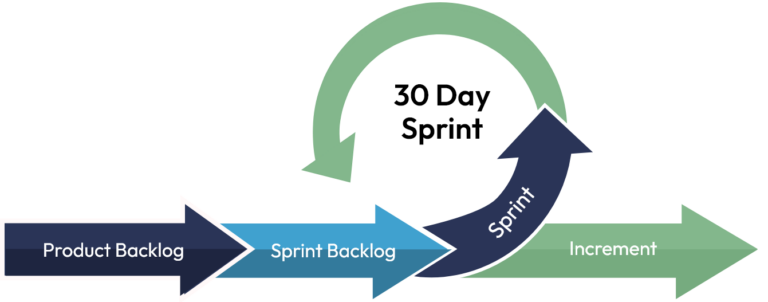
The Steps
1. Product Backlog
A prioritized list of features, enhancements, and bug fixes that represents everything needed for the product.
2. Sprint Backlog
A selection of items from the product backlog chosen for development during a specific sprint, along with a plan for delivering them.
3. Sprint Cycle
A time-boxed period, typically 2 weeks, during which the Scrum team works to complete the items in the sprint backlog.
4. Increment
The sum of all the completed product backlog items at the end of a sprint, representing a potentially shippable product.
Best Practices
Stand-ups
Hold brief daily meetings to synchronize team efforts, discuss progress, and address any obstacles.
Sprint Planning
Clearly define and prioritize tasks at the beginning of each sprint to ensure focused and efficient development.
Regular Reviews
Conduct sprint reviews to demonstrate completed work, gather feedback, and adjust the product backlog accordingly.
Retrospectives
Hold sprint retrospectives to reflect on what went well and what could be improved, fostering continuous improvement and team growth.
DevOps
DevOps is a methodology that integrates development and operations teams to enhance collaboration, automate workflows, and accelerate the delivery of high-quality software through continuous integration and continuous delivery (CI/CD).
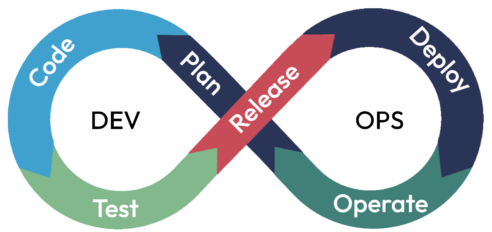
The Steps
1. Plan
Define project requirements, set objectives, and create a roadmap for development and operations.
2. Code
Write and develop code based on the project requirements and plans.
3. Test
Perform automated and manual testing to ensure the code meets quality standards and is free of defects.
4. Release
Prepare and package the tested code for release, ensuring it is ready for deployment to production environments.
5. Deploy
Creating detailed documentation of the wireframe designs, including annotations and specifications, to guide developers during the implementation phase.
6. Operate
Monitor and manage the application and infrastructure, addressing any issues and ensuring the system runs smoothly.
Best Practices
Automation
Automate repetitive tasks such as testing, integration, and deployment to enhance efficiency and reduce errors.
Continuous Integration and Continuous Delivery (CI/CD)
Implement CI/CD pipelines to enable frequent, reliable, and automated code changes from development to production.
Monitoring and Logging
Continuously monitor and log application and infrastructure performance to detect issues early and ensure system reliability.
Collaboration and Communication
Foster strong collaboration and communication between development and operations teams to align goals and streamline processes.
Lean
Lean is a methodology focused on optimizing efficiency by reducing waste, improving processes, and delivering value to the customer through continuous improvement.
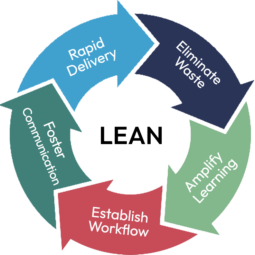
The Steps
1. Establish Workflow
Define and implement efficient workflows that align with the value stream to optimize processes.
2. Foster Communication
Promote open and effective communication among team members and stakeholders to enhance collaboration and problem-solving.
3. Rapid Delivery
Focus on delivering value quickly by streamlining processes and reducing cycle times to meet customer needs more efficiently.
4.Eliminate Waste
Continuously identify and remove activities or resources that do not add value to minimize waste and enhance overall efficiency.
5. Amplify Learning
Encourage a culture of learning and experimentation to continuously improve processes and adapt to changing requirements.
Best Practices
Automation
Automate repetitive tasks to improve efficiency and reduce manual errors.
Continuous Improvement
Regularly review and refine processes to eliminate waste and enhance value delivery.
Monitoring and Measurement
Track performance metrics to identify areas for improvement and ensure processes are meeting objectives.
Collaboration and Communication
Promote strong collaboration and communication across teams to align efforts and drive process improvements.
Rapid Application Development (RAD)
Rapid Application Development (RAD) is a methodology focused on quickly delivering high-quality software through iterative development, user feedback, and continuous refinement.
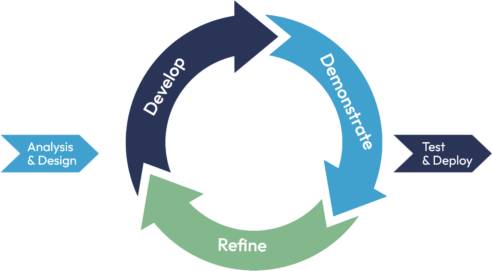
The Steps
1. Analysis & Design
Gather and analyze requirements, and design the system architecture and user interfaces to meet user needs.
2. Develop
Create and build the application based on the analysis and design, focusing on rapid development and iteration.
3. Demonstrate
Present the developed application to stakeholders and users to gather feedback and assess if it meets their needs.
4. Refine
Make adjustments and improvements based on feedback to enhance the application and address any issues.
5. Test & Deploy
Thoroughly test the application for quality and performance, then deploy it to the production environment for end-users.
Best Practices
Automation
Utilize automation tools to accelerate development and streamline repetitive tasks.
Continuous Feedback
Regularly gather feedback from users and stakeholders to ensure the application aligns with their needs and expectations.
Iterative Development
Implement the application in iterative cycles to quickly adapt to changes and incorporate improvements.
Collaboration
Foster close collaboration between developers, designers, and users to enhance communication and ensure alignment throughout the development process.


